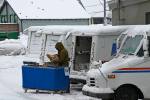OUTDOOR BRIEFS
ARTIST HONORED
Duck Stamp contest winner announced
When most people find out they have won a contest, they are surprised. Artist Sherrie Russell Meline was no different. When she was notified that her painting of a Great Basin Canada goose had been selected the winner of the Nevada Department of Wildlife's 30th annual State Duck Stamp Art Contest, she was stunned ... but that was because she had forgotten she had entered the contest in the first place.
"I had just returned from a show-vacation in Las Vegas and when I got home and read my e-mail, I was absolutely shocked. I had forgotten I had sent the piece in. I am so excited and honored," said Meline of Mount Shasta, Calif.
The winning entry in the annual art contest was selected by a panel of seven judges, including two wildlife commissioners. Her painting will grace the Nevada's 2009-2010 State Duck Stamp.
Meline is no stranger to the Nevada Duck Stamp art contest, having also won in 1987 and 1999. Since starting her work on duck stamps in 1983, she reports that her work has been featured on 30 duck stamps. Her paintings have been on stamps in Idaho, Arizona, California and Texas. Meline also was featured on the Federal Duck Stamp in 2006.
The subject of this year's contest is the Great Basin Canada goose, a subspecies of the Canada goose. The Great Basin Canada goose winters in significant numbers at Nevada's wetlands, which are on the Pacific Flyway.
The contest was sponsored by the Nevada Waterfowl Association and sanctioned by NDOW. This year, there were 27 entries to the contest, with the winner and nine runners-up put on display at the Nevada Waterfowl Association's November fundraising banquet in Fallon. All of the winning entries can be viewed on the NDOW Web site at www.ndow.org/wild/stamp/
GROWING NUMBERS
Turkeys run wild throughout Nevada
It is one thing to hear a barnyard turkey gobble, but hearing one of Nevada's wild turkeys gobble in the woods is a completely different experience. This is especially true for those who get to watch a big tom turkey strut his stuff while gobbling sweet nothings to a nearby hen.
But hearing or seeing a gobbler in Nevada hasn't always been possible. The first attempt to establish a viable population of wild turkeys in the Silver State took place in 1954 when a sportsmen's group released birds near Lovelock, but this proved unsuccessful. Their attempt was followed up in the early 1960s when the Nevada Fish & Game Commission, predecessor to NDOW, liberated Merriam's turkeys in the Spring Mountain Range near Las Vegas and in the Carson Range near Reno.
Although limited hunting seasons were in the Carson Range during the fall of 1965, 1966 and 1967, a lack of hunter success brought an end to the fish and game agency's attempts to establish a wild turkey population in Nevada. However, when surrounding states began having success in establishing populations of the Rio Grande subspecies of turkey in the late 1980s, biologists' interests in establishing a turkey program were rekindled.
In 1987, NDOW obtained wild Rio Grande turkeys from California and released them at the Mason Valley Wildlife Management Area near Yerington. This effort was successful as the Rio Grande turkeys seemed to adapt easily to Nevada's arid climate. Since then, populations of Rio Grande turkeys have been established in Churchill, Clark, Elko, Humboldt, Lander, Lincoln, Lyon and Pershing counties. Each of these counties now hosts annual spring turkey hunting seasons, which are growing in popularity among Nevada's hunters.























